Artists
‘We Don’t Always Have to Be Sexual’: Danielle Mckinney on Her Potent Portraits of Feminine Solitude
The star painter's Black female figures seem to revel in the spaces she has created for them.
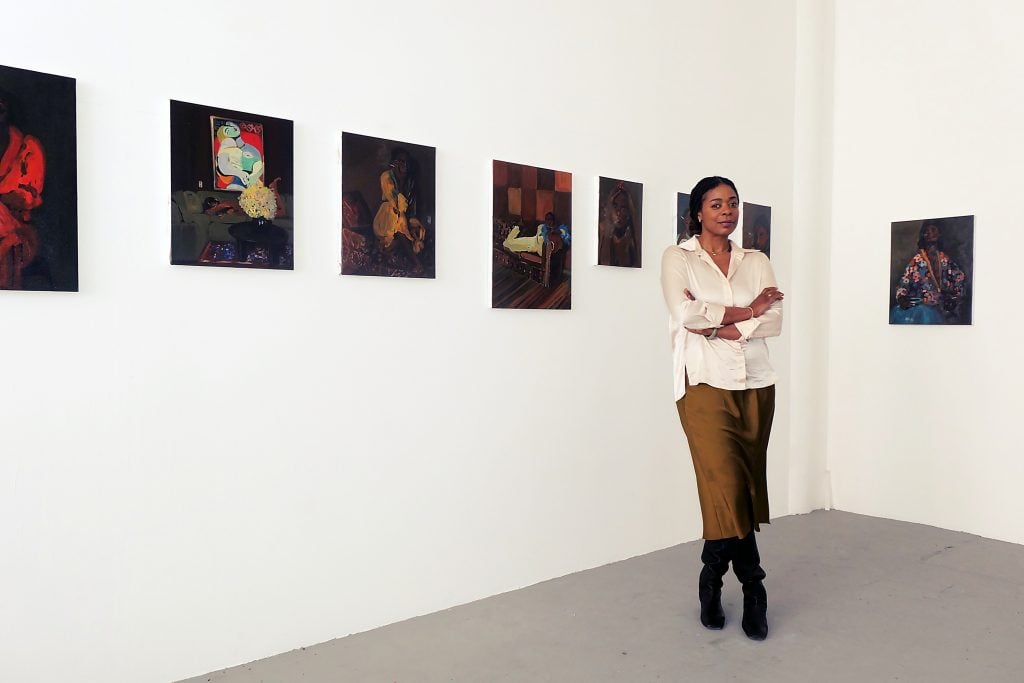
The star painter's Black female figures seem to revel in the spaces she has created for them.

Emily Steer

Danielle Mckinney’s specialty is rest and relaxation. The American artist creates sumptuous paintings that depict Black women in moments of peaceful solitude, where her subjects are often draped in silk, velvet, or feathers, and surrounded by soft furnishings. They appear blissfully unaware of the viewer’s gaze—it seems as if they revel in the spaces Mckinney has created for them.
“I’m an only child, a deep introvert,” said Mckinney in an interview ahead of her solo show that opens at Fondazione Sandretto Re Rebaudengo in Turin on March 19. Titled “Fly on the Wall,” it includes all new work and one painting that the artist keeps in her own collection, Shelter (2023)—a moody painting that includes a butterfly resting on her subject’s finger.
Depicted within their own homes, her painted figures ooze a comfortability. In some works, they clutch a lit cigarette that burns warm orange at the tip. In others, their chin sits gently on their hand. “I think as a child my world was very traumatic outside, but in the house it was safe,” noted Mckinney. “I enjoy quiet time, it fuels me. I paint what I know, and, of course, I’m a Black woman and I enjoy rest.”
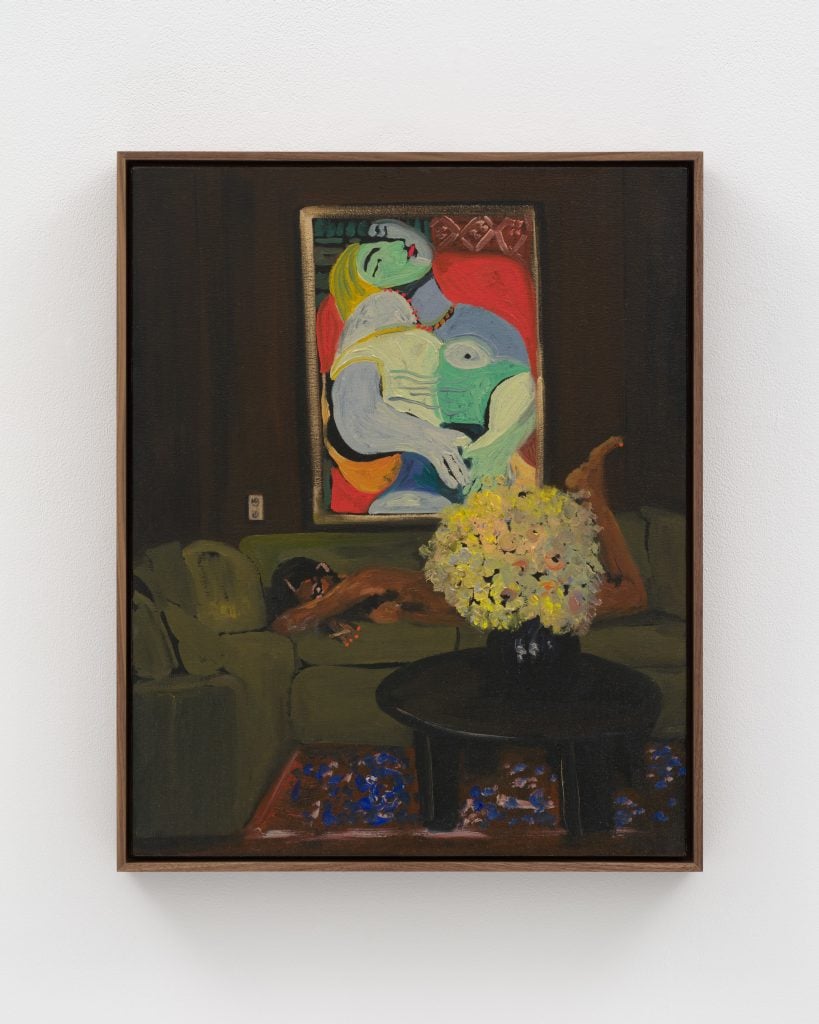
Sandman, (2024). Copyright of Danielle Mckinney and courtesy of Marianne Boesky Gallery
When her figures are depicted nude, Mckinney captures an easy state of undress, which is devoid of overt sexuality or objectification—it is instead a portrait of natural comfort with the body away from prying eyes. “What does it look like when you go home, turn everything off, and you aren’t scrolling on your phone? Or when you wake up from a nap? What do you look like in those moments? You look like yourself, which is absolutely beautiful.”
There is a timelessness to the women’s clothing and the interiors that Mckinney paints. Many of her pieces come from photographic source material, and she is particularly inspired by magazine photography from the 1970s. There is an air of tactile glamour to the spaces she creates, and a deep opulence rendered by the lighting.
Inspired by Old Masters techniques of building a painting up from a burnt umber base, Mckinney begins her works with a black background. She then paints details into this which evoke a sense of warm interior lighting. “You need that darkness to set the tones and the mood,” she said. “The light creates the comfort. When you put soft light in your home, it’s beautiful, it’s cuddly.”
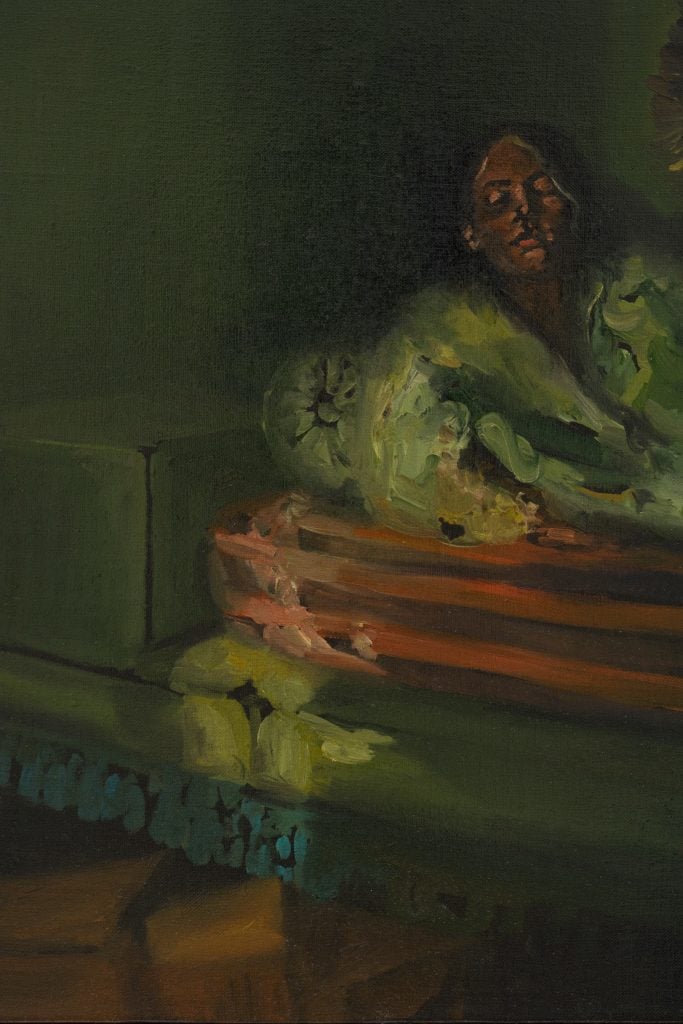
Detail view of Renewal, (2024). Copyright of Danielle Mckinney and courtesy of Marianne Boesky Gallery
While her canvases evoke a sense of idealized serenity, her time in the studio is often very different.“I’m the complete opposite!” she laughed. “If you saw me before this interview, I was literally about to throw a canvas at the wall. Paint can be so intense which is why I love it so much. I’ll have everything in my head—what I want it to say, how I want it to feel, the colors—and then I’ll put it down and it’s a hit or miss, like shooting a bow and arrow. Sometimes you get it and sometimes you don’t. It’s a frustrating practice but very rewarding when you make a beautiful painting.”
Interest in Mckinney’s work has soared since she turned her focus so singularly to painting. Her solo booth with Marianne Boesky Gallery at Frieze London last October was a sellout hit, and in 2023, her canvas We Need to Talk sold for just over $200,000, around ten times its estimate. Beyoncé famously owns one of her paintings, and she is also in the collections of major institutions such as Dallas Museum of Art and the Hirshhorn Museum and Sculpture Garden at the Smithsonian.
Her painting evolved from a photography practice. She compared working her black backgrounds with the process of developing photographs with chemicals to bring out the light. Before the pandemic, she was photographing out in the street, but her own experiences in the home during lockdown reignited her painting practice.
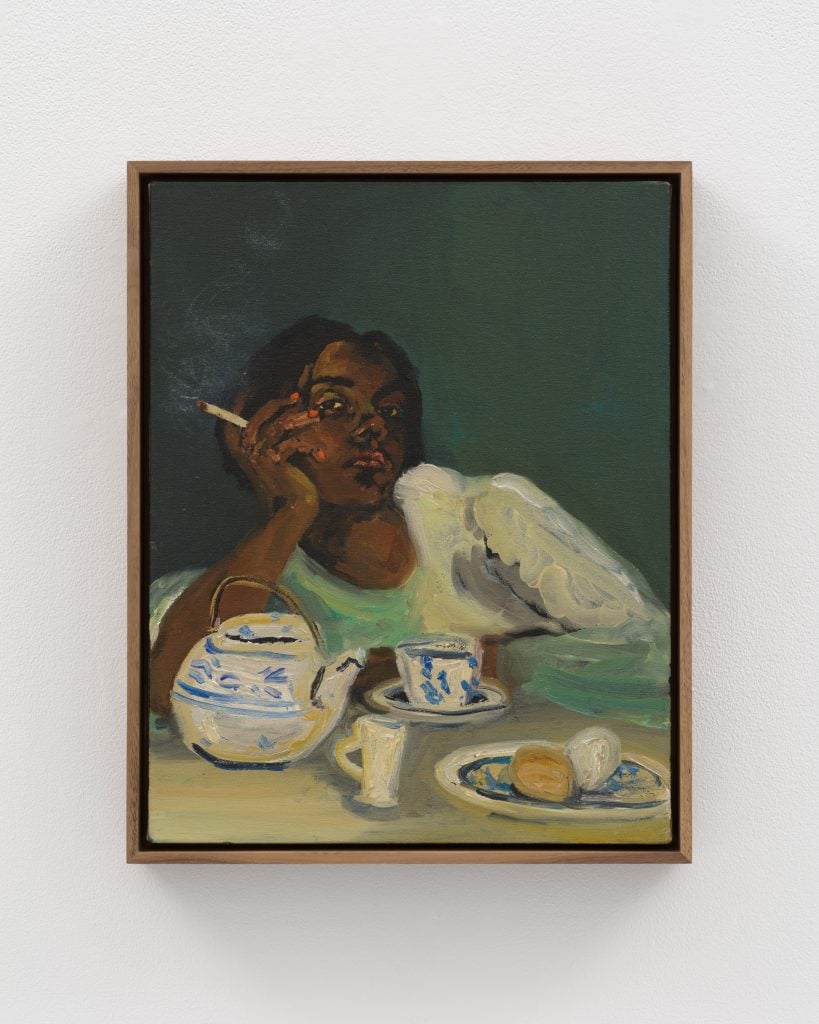
Easy Over, (2023). Copyright of Danielle Mckinney and courtesy of Marianne Boesky Gallery
While the shift to almost exclusively painting interior scenes has been relatively recent, she sees a through line with her early experiences of creativity and making. “I’m tuning into this universal thing,” she said. “But I’ve been doing it since I was a child. I’d build these little dioramas, these houses, in shoe boxes and put people in them. These moments of relaxing on a sofa or lounging with a cigarette is something I just subconsciously am so familiar with.”
While her paintings speak directly to physical interior space, they also reflect the interior of the mind. The feel of the physical interiors offer insights into the emotional experience of the women in the paintings. These women also have an emotional impact on the artist while she is working. “They’re like little people to me,” she said. “I was sad when the work left because they keep me going. I’ll be frustrated and I look at them, and they’re asleep. And they’ve been asleep for two weeks, they don’t want to be bothered.”
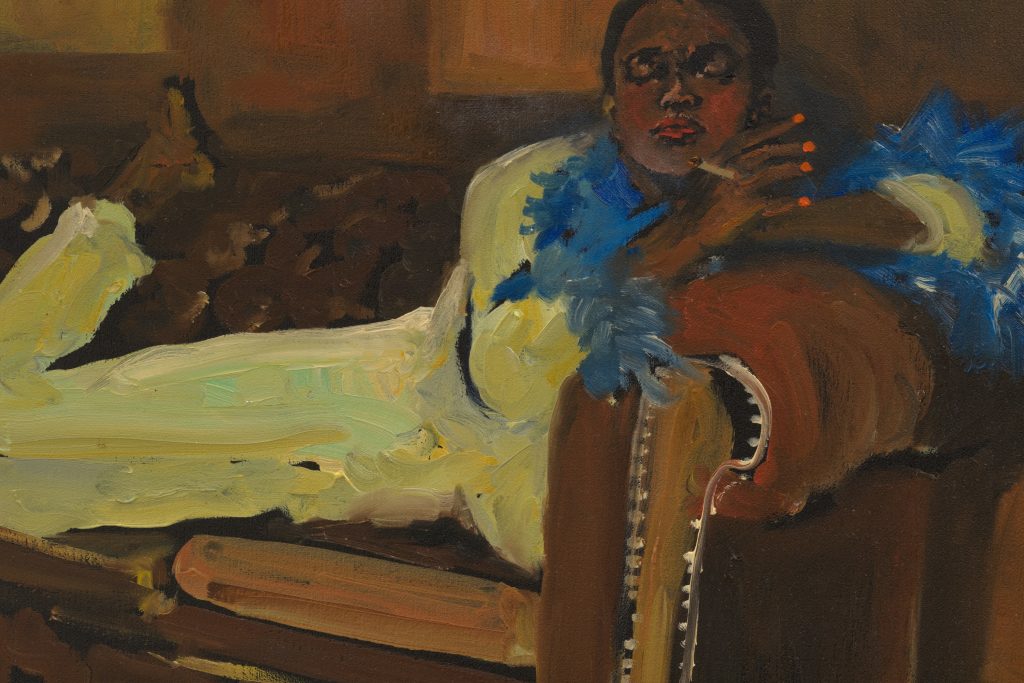
Detail view of Eventide, (2024). Copyright of Danielle Mckinney and courtesy of Marianne Boesky Gallery
In searching for source material online, Mckinney has noticed an upsetting trend in which many terms aimed at finding women in moments of relaxation lead to porn. “I’ll type in things like ‘female reclining on sofa’ and immediately it goes to pornography,” she said. “We don’t always have to be sexual.”
She noted that, when her painted subjects have their breasts out, it is “more the vulnerability to be seen but not seduced,” she said, adding “I respect the femininity.”
The artist was raised by her mother, grandmother, and aunt, and in some ways sees these paintings as an homage to the exclusively female presence within her own childhood home. “I was really watching these women go through life changes,” she said. “I had to grow up very fast and I was also a watcher. I watched these women find themselves. People ask if I’m painting myself. I don’t think I am; I think I’m painting these memories. A lot of it is my mum. She is always playing smooth R&B, she’s got some tea going, she’s from the South. It’s this amazing aura.”
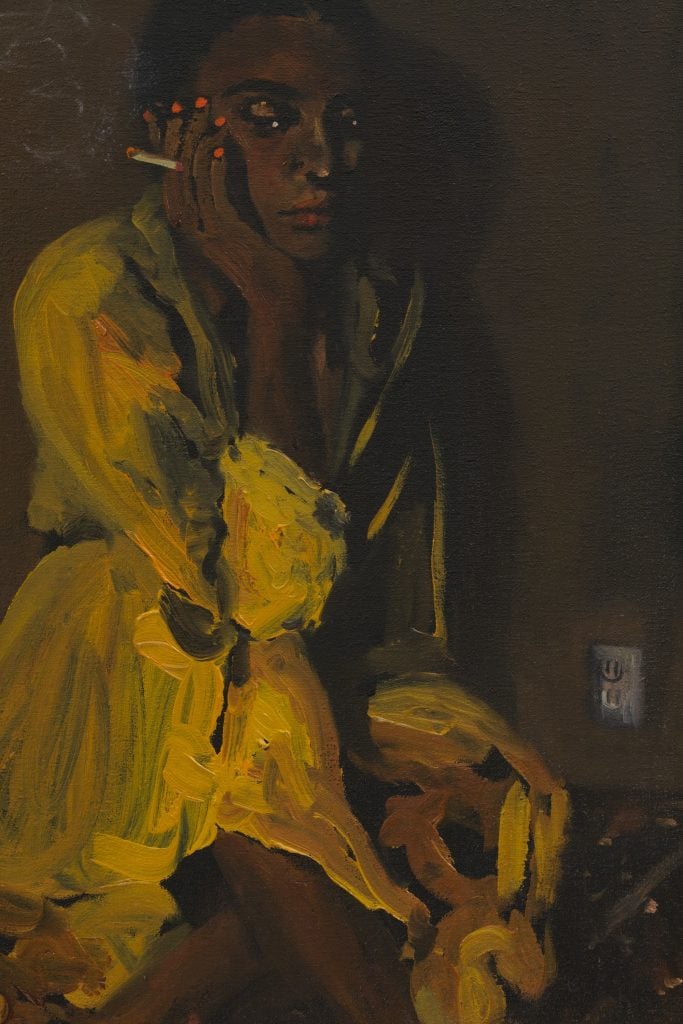
Detail view of Haze, (2024). Copyright of Danielle Mckinney and courtesy of Marianne Boesky Gallery
While she doesn’t see the women in the works as direct reflections of herself, she does note that they seem to have grown up with her. “My husband’s an artist as well and he mentioned that the women seem to have matured,” she said. “I think I noticed it with this show too. The women seemed a bit more settled in themselves. It’s when you’ve been through things and there’s a sense of knowing.”
Mckinney’s work challenges the fast pace of the contemporary world, in which many people find themselves burned out, filled with guilt at switching off, or hooked to social media and unable to relax even within their own homes. Her paintings invite viewers to give themselves a moment of peace. “People write to me and say thank you for allowing me to see myself taking a break,” she said. “And it’s not just Black women. I’ve had many other people, including Caucasian men, telling me I have helped them to see themselves, and that it’s okay to stop. We live in a world where we’re running. There’s beauty in rest.”
